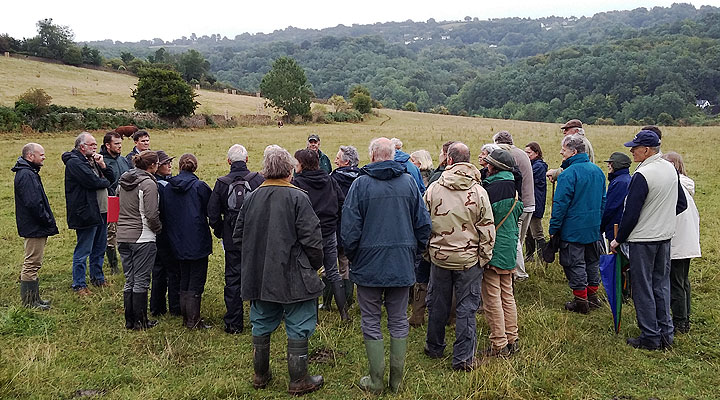Pasture for Life farm hosts new meadows group

Thirty people gathered this week (19 August) to view special meadows created in south Herefordshire by Pasture for Life farmer Simon Cutter, for a meeting of the new Herefordshire Meadows Network.
The new group has been set up by a collection of farmers, conservationists and landscape advisors with the support of organisations like the Herefordshire Wildlife Trust. The aim is to bring together these different groups who have a common interest in managing grassland and biodiverse meadows.
Simon is based at Model Farm near Ross-on-Wye, but also farms at the Courtfield Estate, where the species-rich meadows are.
“When we took this farm over 13 years ago it had been in arable and potato production,’ Simon explained. “The soil was dead and the thistles were eight feet high!
“The landlord wanted to restore the estate to parkland. So with the support of a Higher Level Environmental Stewardship agreement we set about re-establishing grazing meadows. I brought in my herd of Hereford cattle, and they started to drive the ecosystem that is here today.”
The meadows visited were also featured on BBC Countryfile last year where both Simon and Russ Carrington from the Pasture-Fed Livestock Association spoke to John Craven about the Pasture for Life brand and traceability of the meat. You can read more about this here.
The ecologists at the meeting were particularly impressed with the plant diversity in the meadows, spotting a number of rare pasture species, which to Simon’s knowledge had not been included in the original seeds mixture.
“This just shows what can be stored in the soil’s natural seed bank for many years, even decades,” said Sue Holland from the Herefordshire Wildlife Trust.
Simon keeps his cattle at a fairly low stocking rate, allowing him to rotate them around the different meadows 52 weeks of the year.
“By not grazing the meadows too tight we can plan to have plenty of fresh grazing through the winter, as well as creating the right environment for so many different plant species to thrive,” Simon said.
“Any of the more fibrous plant material that doesn’t get eaten, helps form a thatch in the sward to help carry the livestock through the winter and prevent poaching – even on these heavy clay soils. It also helps to keep the soil warm, so we have early fresh grass growth in the spring.
“The animals do very well out here and I believe self-medicate using all of the different herbs in the pasture. Without the need for any additional inputs this system is very low cost, and at the same time these meadows produce very high quality, healthy meat”.
Simon also runs a small farm shop at Model Farm, where he sells the meat reared on his farm. He also delivers to buying groups in Bristol and Birmingham. Find out more here.



